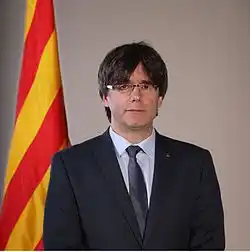Catalan ethnicity indicates genetic origins in the region of Catalonia in north-eastern Spain. This is a part of the Spanish state, but one which has a long history of asserting its independence from the central government in Madrid, at times trying to effectively establish Catalonia as a separate country. Owing to this, Catalonia has developed its own customs and culture which differ in some significant respects from those of wider Spain. In modern times, this has even resulted in Catalonia being designated as an autonomous community within Spain and being granted a statute of autonomy. While there are some slight ethnic distinctions between the people of Catalonia and the rest of Spain, the independent streak exhibited by Catalans is also tied to certain historical issues and also the region’s affluence compared to the rest of Spain.[1]
Research your ancestors on MyHeritage
Catalan historyCatalan history

Catalonia is a region in north-eastern Spain with its own distinct history, culture, and traditions, ones which have seen it agitate for considerable independence from the central government in Madrid throughout Spanish history. The region’s history mirrors that of other parts of Spain in ancient times in so far as it was inhabited by a range of different peoples like the Celts, Lusitanians, and Phoenicians before the arrival of the Romans. It was also overrun by the Germanic tribes, notably the Visigoths, like the rest of Iberia in the fifth century CE. However, its history has distinct elements from the rest of Spain thereafter.
While Catalonia was occupied by the Muslims who conquered Spain in the eighth century, it was soon restored to Christian rule when the Frankish Emperor Charlemagne conquered it. Consequently, Catalonia has the distinction of being the only part of Spain that formed part of the Carolingian Empire in medieval times.[2] Later, Catalonia came to form part of the Kingdom of Aragon, which had its capital in Zaragoza, but the true identity of which lay to the east in Barcelona and the Mediterranean empire which it acquired in the Balearic Islands, Sardinia, Sicily and Naples between the thirteenth and fifteenth centuries. This also emerged by the early modern period as the wealthiest part of Spain based on the trade of Barcelona. Thus, even as a centralized Spanish state began emerging in the sixteenth century, Catalonian regional autonomy was also growing.[3]

The first major signs of Catalonia’s unwillingness to accept the control of Madrid came in the seventeenth century as successive governments tried to impose heavy taxes on the wealthy Catalonians. This resulted in the outbreak in 1640 of the so-called Reaper’s War or Catalan Revolt against King Philip IV of Spain, part of a series of rebellions that the Spanish crown faced in the 1640s. In the case of Catalonia, it would last for nearly twenty years, only finally being suppressed in 1659 when Spain made peace with France with whom it had been at war for decades and whose government had been providing extensive support to the Catalan rebels.[4] The Catalan Revolt of the 1640s and 1650s in many ways set the template for Catalonia’s modern quest for independence. This was elevated in the nineteenth century when a Catalan literary, cultural and political revival occurred. Yet the Catalan movement was set back gravely by the repression of the Francoist regime which came to power at the end of the Spanish Civil War in 1939.[5] In the aftermath of Franco’s dictatorship, Catalonia pressed for regional autonomy and the new constitution of 1978 acknowledged the regional independence and language of the Catalans. However, calls for full independence and the creation of a completely independent Catalan state have never faded and have recently been rejuvenated by Catalan politicians like Carles Puigdemont who somewhat controversially approved laws permitting an independence referendum in 2017 superseding the Spanish Constitution and earning the opposition of the central government in Madrid.[6]
Catalan cultureCatalan culture

There are many distinct elements to Catalan culture, which have driven the desire for political independence from the rest of Spain over the centuries. For instance, the Catalan language is a distinct language that is widely used across the region instead of Castilian Spanish. The cuisine here mirrors that of the rest of Spain, but might be said to also incorporate elements of dishes that are more common in southern France and in particular in Italy, the latter being a result of the region’s historic ties to cities like Naples. Catalonia also has one of the oldest attested musical traditions of any region in Europe, with the Libre Vermell de Montseratt, ("The Red Book of Montseratt"), dating back to the fourteenth century, being a compendium of songs played in Catalonia over 600 years ago.[7] Sport is also central to Catalan culture, in particular support for Barcelona Football Club, whose rivalry with Real Madrid over the decades is in many ways a continuation of the clash between regional autonomists in Barcelona and the central government in Madrid.[8] Catalonia has also a proud artistic and architectural tradition of its own distinct from the rest of Spain. Salvador Dali, for instance, was born in Catalonia, while Antoni Gaudi, a Catalan architect and designer who is viewed as the greatest proponent of Catalan Modernism, is famed for designing and beginning the construction of the Sagrada Família cathedral in Barcelona, one of the most unique pieces of architecture built anywhere in the modern world.[9]
Catalan languagesCatalan languages
While Spanish is the official language of Spain in general, Catalan and Aranese also have official status in Catalonia. Catalan, like Spanish, is ultimately derived from Latin. It emerged as one of the many dialects used across Spain during the Middle Ages, but whereas most parts of Spain gradually began using Castilian Spanish from the fifteenth century onwards, people in Catalonia retained their own language to a significant extent. This is not entirely uncommon for other regional languages of Spain, like Euskera, Asturian, Galician and other Spanish languages with many hundreds of thousands of speakers still today. Catalan, however, is more common, with upwards of nine million people speaking it either as a first language or a second language. In part, this is owing to a conscious Catalan literary revival in the nineteenth century, which rejuvenated it and challenged the growing dominance of Castilian Spanish.[10] Aranese is not a widely used language in Catalonia. It is largely restricted to the Aran Valley in the very north of the country near the Pyrenees Mountains. It is an Occitan language, which is a family of Romance languages derived from Latin which primarily developed in southern France in the medieval period and continued to be spoken widely there until modern times. While Aranese is widely understood and spoken in the Aran Valley, this still only equates to a few thousand speakers.[11]
See alsoSee also
Explore more about ethnicity estimatesExplore more about ethnicity estimates
- MyHeritage DNA at MyHeritage
- Ethnicities around the world at MyHeritage
- What Is My Ethnicity? How MyHeritage Estimates Ethnicities at MyHeritage Knowledge Base
- Where's My Ethnicity?!: Why An Ethnicity Might Not Show Up In Your DNA (and How To Find Evidence Of It Anyway) at MyHeritage Knowledge Base
References
- ↑ Catalonia profile. BBC News
- ↑ Catalan ‘Franks’ on the Iberian Peninsula. Ebrary
- ↑ Aragon, Catalonia, and Valencia, 1276–1479. Encyclopedia Britannica
- ↑ The Reaper’s War: A Peasant Uprising in Catalunya. Metropolitan Barcelona
- ↑ The Ghost of Franco Still Haunts Catalonia. Foreign Policy
- ↑ Catalonia's 2017 independence referendum: a timeline. Catalan News
- ↑ https://klebergdesign.com/llibre-vermell-de-montserrat Llibre Vermell de Montserrat Kleberg Design
- ↑ FC Barcelona vs. Real Madrid: Athletic Rivalry or Political Tool? Washington University in St. Louis Political Review
- ↑ HISTORY OF THE BASÍLICA. Temple Expiatori de la Sagrada Família
- ↑ Origins and History. Generalitat de Catalunya
- ↑ Aranese: Spain's little-known language. BBC Travel

